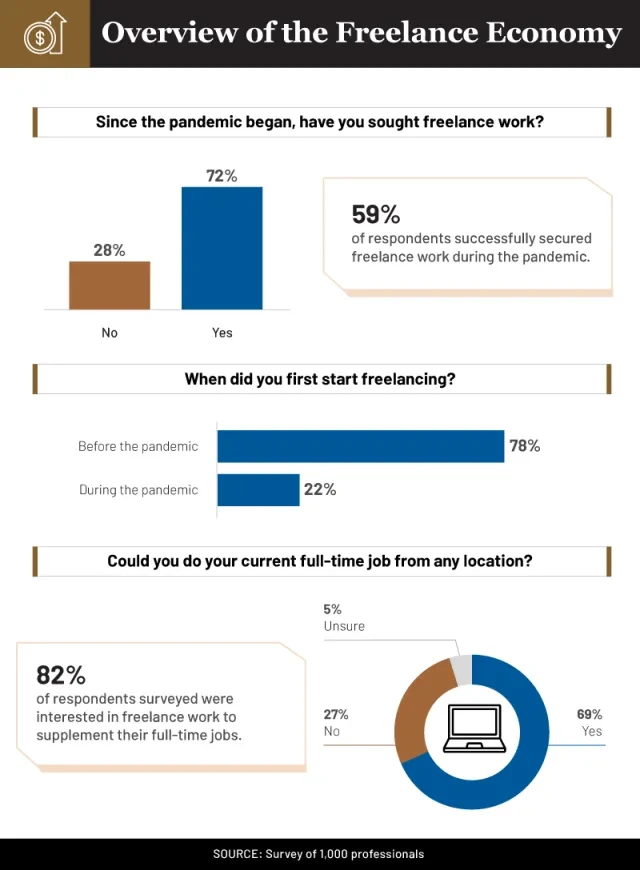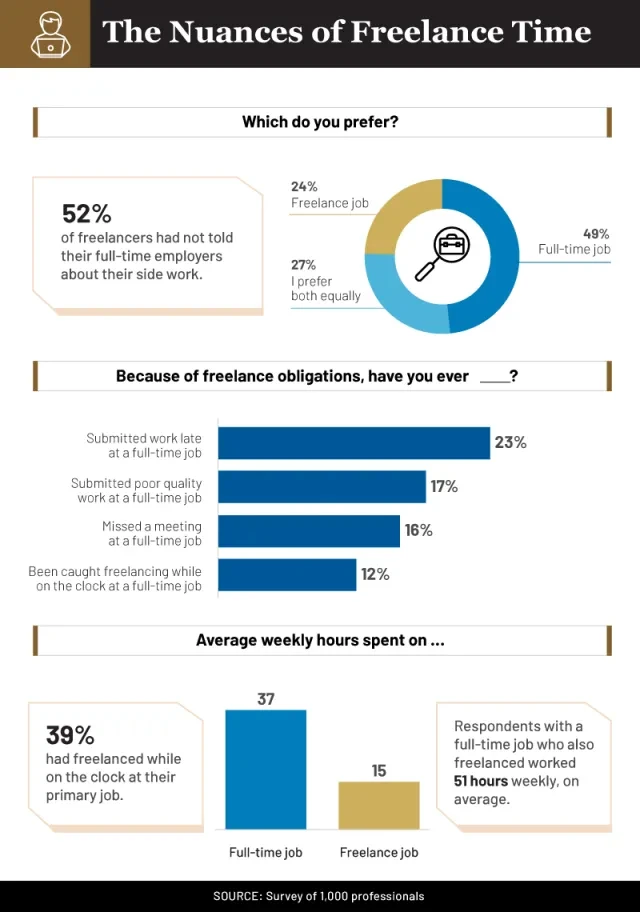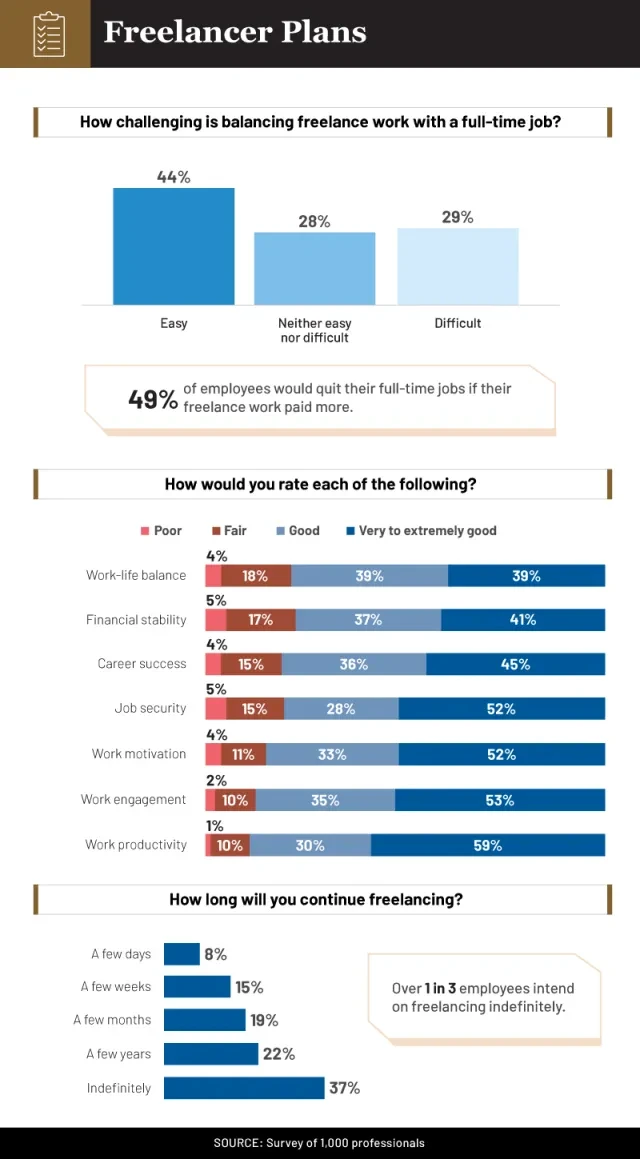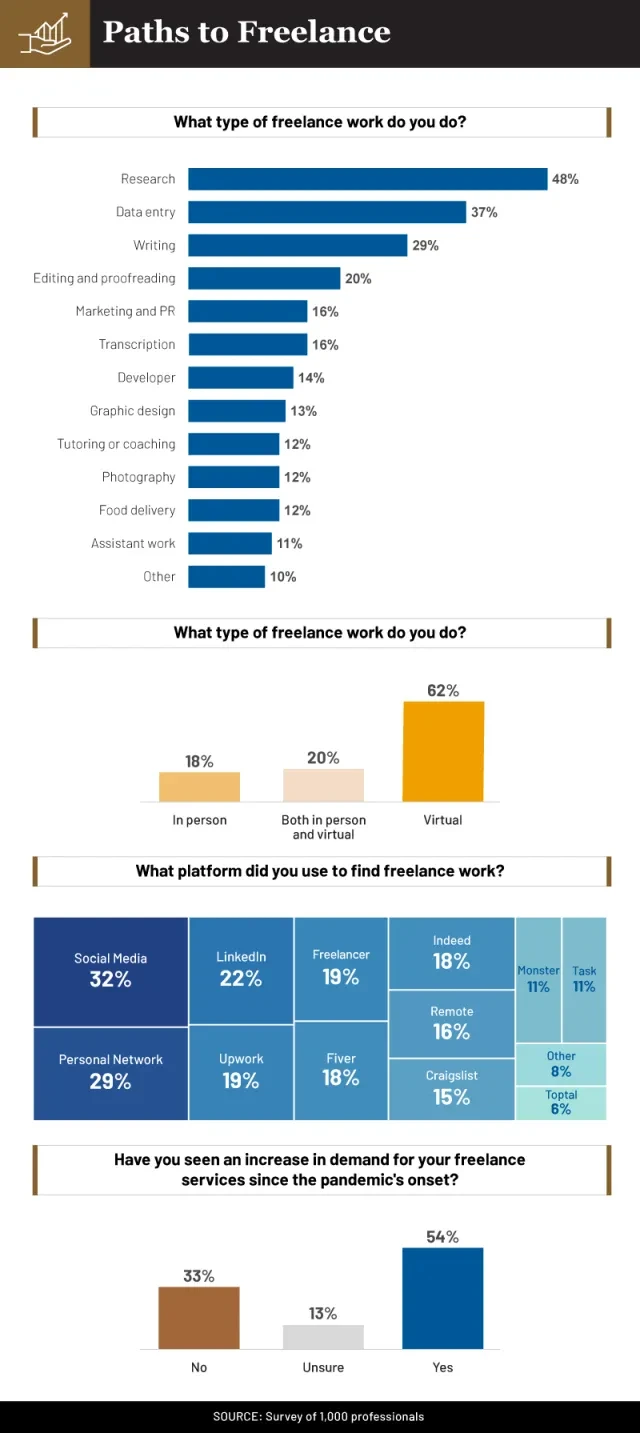- Administración
- Artículo
- Lectura de 6 minutos
- Last Updated: 01/06/2021
The 2020 Freelance Economy Explored

Table of Contents
To understand how employed people are approaching freelance work during the COVID-19 pandemic, we surveyed 1,000 professionals about the freelance work they’d taken on in recent months.
Study Highlights According to Survey Respondents
- 82% of employed people are interested in freelancing in addition to their full-time job since the pandemic began.
- 59% of people working full time have started freelance work since the pandemic’s onset.
- Over 2 in 10 employed people started freelancing during the COVID-19 pandemic.
- 52% of respondents haven’t told their full-time employer about their freelance work.
- 39% of respondents freelanced while on the clock for their primary job.
- Over 1 in 3 employed people intend on freelancing indefinitely.
- 54% of respondents have seen an increase in demand for their freelance services.
- 24% of respondents prefer their freelance work over their full-time job.
As many businesses contemplate when the time might be right for their employees to return to the workplace, some American workers are adapting to their remote work circumstances in more ways than one. As industries shift to accommodate the fluctuations in business and demand caused by the COVID-19 pandemic, the popularity of freelance work continues to rise. While there is no legal definition for freelancer, it generally refers to a worker who is classified as an independent contractor and is self-employed. Independent contractors generally bid for or accept temporary jobs or projects with different companies, usually receiving a set payment for the completed work. Independent contractors are also generally responsible for their own expenses, and file taxes differently than an employee of a company.
However, classification of workers is defined differently under different laws and regulations, and employers need to be mindful of all applicable laws when classifying workers.
As it turns out, the shift to more freelance work triggered by the economic impact of the COVID-19 pandemic might not be exclusive to younger generations. Working Americans of all ages appear to be taking advantage of the influx of freelance opportunities, short-term projects, and consulting gigs to help supplement their income.
Read on as we explore how many workers are taking on freelance jobs in addition to their full-time employment, how many have told their bosses about it, how much time they’re putting into these additional employment opportunities, and the struggles workers are encountering trying to balance it all.
Joining the Freelance Economy

The freelance economy has been booming for years. In 2018, 56.7 million Americans were participating in freelance work, an increase of 3.7 million since 2014. Since the COVID-19 pandemic began in 2020, 72% of employees surveyed had sought out freelance work, with 59% securing contract freelance work.
While 78% of Americans currently engaged in freelance work picked up their gigs before the COVID-19 pandemic began, 22% of workers currently freelancing only began doing so during the health crisis. A vast majority of employees (82%) were interested in adding freelance work on top of their existing full-time jobs. For some employees, current remote work flexibility may be inspiring them to pursue freelance work – of the 1,000 employees polled, 69% identified having the ability to do their jobs from anywhere, and 5% were unsure.
A Day in the Life of a Freelancer

More than half of freelancers (52%) admitted to not telling their primary employers about the side work they’d picked up. While a 49% of working Americans preferred their full-time jobs, 24% preferred the work they’d been doing in their freelance jobs, while even more (27%) enjoyed both equally.
For some people, finding a balance between their freelance work and their primary job created some challenges. Twenty-three percent of employees acknowledged submitting work late at their primary job due to freelance obligations, and 17% submitted poor quality work at their primary job. While less common, 16% of employees confessed to missing a meeting at their full-time job because of their freelance work, and 12% of employees had been caught freelancing while on the clock at their main job. More than one third of workers (39%) identified having freelanced while on the clock for their main job, and respondents doing both full-time work and freelancing averaged over 51 hours of weekly work, on average.
Finding Balance During the Pandemic

While 44% of employees considered balancing their freelance work with their full-time job an easy task, 29% acknowledged it was hard to find the right harmony between their primary job and their freelance work. Nearly half of those surveyed would quit their full-time job if freelance work paid more. Opting to freelance in addition to working a primary job wasn’t always a decision workers made out of necessity, either. More than half of respondents taking on freelance work in addition to their primary jobs rated their job security as excellent (52%) and had similarly positive outlooks on their workplace productivity (59%) and motivation (52%).
Not all Americans freelancing saw freelance work as a long-term solution for income. Eight percent expected to freelance for only a further few days, while 15% planned on freelancing for a few additional weeks and 19% for a few more months. While some only began freelancing after the COVID-19 pandemic began, more than 1 in 3 workers expected to continue freelancing indefinitely.
Finding Freelance Work During COVID-19
The most common contract work included research (48%), followed by data entry (37%), writing (29%), editing and proofreading (20%), and marketing or PR (16%). For 62% of workers, freelance jobs were performed in a virtual environment, while 18% worked them solely in person, and 20% did both virtual and in-person work.

More than half of freelancers (54%) reported seeing an increase in demand for their services since the COVID-19 pandemic began, while 33% saw no increase, and 13% were unsure if an increase had taken place. Social media (32%) and personal networks (29%) were the most common platforms used to find freelance work, though LinkedIn (22%), Upwork (19%), and Fiverr (18%) were also popular resources for people looking for contract work.
Helping Employees Navigate the New Normal
The freelance economy was already booming for workers and small businesses alike, but the COVID-19 pandemic may have increased the demand for freelance work, as employees transition to virtual work environments.
Many people are taking on freelance jobs in addition to their primary, full-time employment, occasionally causing conflict between their existing work responsibilities and the side work they’ve procured. While the majority preferred the work they do in their full-time jobs, many would consider leaving those roles if their freelance work paid better.
We know that business owners may be relying more heavily on independent contractors during these unprecedented times. That’s why Paychex is here to help you navigate the compliance and HR challenges of managing workers. With our COVID-19 Help Center, we’ll help support your employees through their challenges, and understand the unique opening guidelines based on your location and industry. If you have questions about PPP loan forgiveness or your state’s COVID-19 laws and regulations, we’re here to help. Visit us online at Paychex.com today to learn more.
Methodology and Limitations
We collected responses from 1,000 professionals by administering online surveys via Amazon Mechanical Turk. To qualify for the survey, respondents had to indicate that they work a freelance job in addition to full-time employment. Of the 1,000 professionals polled, 43% of respondents were female, 57% were male, and less than 1% identified as nonbinary. Respondents ranged in age from 18 to 71 with an average of 38 and standard deviation of 11 years. An attention-check question was used to identify and disqualify respondents who failed to read questions and answers in their entirety. The main limitation of this study is the reliance on self-report which is faced with several issues such as, but not limited to, attribution, exaggeration, recency bias, and telescoping. This survey ran during July 2020.
Fair Use Statement
Navigating the pandemic for businesses and their employees can be complicated. Help share these insights with your readers for any noncommercial use by including a link back to this page in your story so our team of creative contributors earn credit for their hard work.
Tags







